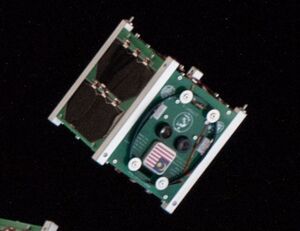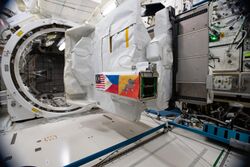Engineering:UiTMSAT-1
 UiTMSAT-1 in Space | |
| Mission type | Technology demonstration |
|---|---|
| Operator | Universiti Teknologi MARA |
| COSPAR ID | 1998-067PD |
| SATCAT no. | 43589 |
| Website | birds2 |
| Mission duration | 6-9 months (planned) |
| Spacecraft properties | |
| Spacecraft type | 1U CubeSat |
| Manufacturer | Universiti Teknologi MARA |
| Launch mass | 1.11 kg |
| Dimensions | 10 × 10 × 10 cm |
| Start of mission | |
| Launch date | 29 June 2018, 09:42 UTC |
| Rocket | Falcon 9 Full Thrust |
| Launch site | Cape Canaveral Air Force Station , SLC-40 |
| Contractor | SpaceX |
| Deployed from | International Space Station |
| Deployment date | 10 August 2018 |
| End of mission | |
| Decay date | 20 November 2020 |
| Orbital parameters | |
| Reference system | Geocentric orbit |
| Regime | Low Earth orbit |
| Perigee altitude | 398.6 km |
| Apogee altitude | 407.2 km |
| Inclination | 51.6° |
| Period | 92.5 minutes |
Joint Global Multi-nations Birds Satellite | |
UiTMSAT-1 was a Malaysian nanosatellite, built primarily by Universiti Teknologi MARA (UiTM) as part of the multi-nation Birds-2 project. The 1U CubeSat was launched into space on 29 June 2018 and deployed from the International Space Station (ISS) on 10 August 2018.
Background
Malaysia has had several satellites in orbit, beginning with the MEASAT constellation, first operational in 1996. Their first microsatellite, TiungSAT-1, was launched in 2000.[1]
Development
Planning for the mission began in December 2016 at the Kyushu Institute of Technology (KIT). UiTM postgraduate students Syazana Basyirah Mohammad Zaki and Muhammad Hasif Azami developed the satellite over a 19-month period and collaborated with eight other students from the Philippines , Bhutan, and Japan. This collaboration also inspired the creation of a new Communication Satellite Centre at Universiti Teknologi MARA (UiTM).[2]
Objectives
- Demonstrate an Automatic Packet Reporting System digipeater to communicate with amateur radio stations.
- Detect a specific type of solar radiation called "single event latch-up".
- Measure magnetic fields through the use of an Anisotropic Magneto Resistance Magnetometer.
- Act as an Earth Imaging Camera.[2]
Launch and mission
UiTMSAT-1 was launched to space on 29 June 2018 by the Falcon 9 Full Thrust rocket at Cape Canaveral Air Force Station in Florida, United States as part of the SpaceX CRS-15 Commercial Resupply Service mission.[2] Maya-1 and BHUTAN-1, which were also developed under the Birds-2 project, were among the payload of the rocket.[3] All three nanosatellites were deployed from the International Space Station (ISS) and achieved orbit on 10 August 2018.[4][5]
References
- ↑ "Satellite Industry Developments". Malaysian Communications and Multimedia Commission. 2008. pp. 28–29. https://www.skmm.gov.my/skmmgovmy/media/General/pdf/Satellite_Industry_Developments_compressed.pdf.
- ↑ 2.0 2.1 2.2 Mustafa, Zulita. "UiTMSAT-1 puts Malaysia at the final frontier". https://www.nst.com.my/education/2018/07/391936/uitmsat-1-puts-malaysia-final-frontier.
- ↑ Panela, Shaira (29 June 2018). "Philippines launches first CubeSat into space". Rappler. https://www.rappler.com/science-nature/earth-space/206090-philippine-launches-cube-satellite-space-june-29-2018.
- ↑ "CubeSat Maya-1 successfully deployed to space". Philippine Council for Industry, Energy and Emerging Technology Research and Development. August 31, 2018. http://pcieerd.dost.gov.ph/news/latest-news/322-ph-cubesat-maya-1-successfully-deployed-to-space.
- ↑ Bernama (August 11, 2018). "UiTM creates history with launch of satellite into orbit". New Straits Times. https://www.nst.com.my/news/nation/2018/08/400225/uitm-creates-history-launch-satellite-orbit.
 |



